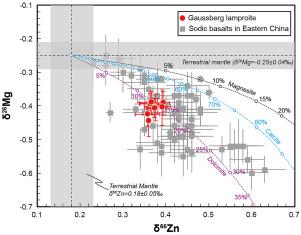Chemical Geology ( IF 3.6 ) Pub Date : 2022-08-19 , DOI: 10.1016/j.chemgeo.2022.121067 Jian-Qiang Liu , Li-Hui Chen , Xiao-Jun Wang , Xiao-Yu Zhang , Gang Zeng , Saskia Erdmann , David T. Murphy , Kenneth D. Collerson , Tsuyoshi Komiya , Lukáš Krmíček

|
Lamproites are rare mantle-derived peralkaline ultrapotassic rocks, and they are commonly geographically associated with the ultramafic lamprophyres and kimberlites. Their unique geochemistry and mineralogy make determining their mantle source and origin important because of the significance for inferring specific geodynamic processes. In this study, we further examine lamproite petrogenesis using new Mg and Zn isotopic data for the typical Gaussberg lamproites, Antarctica, the source of which were thought to be contributed by recycled crustal materials. Results show that these lamproites have lower δ26Mg (−0.44‰ to −0.39‰) and higher δ66Zn (0.36‰ to 0.39‰) values than terrestrial mantle (δ26Mg = −0.25 ± 0.04‰, δ66Zn = 0.18 ± 0.05‰). The post-magmatic alteration and crustal contamination as well as fractional crystallization and partial melting cannot account for these anomalous Mg and Zn isotopic values. By contrast, the involvement of sedimentary carbonates which are characterized by light δ26Mg (average approximately −2.0‰) and heavy δ66Zn (average ~ +0.91‰) values in their mantle source can explain these Mg and Zn isotopic anomalies. Quantitative modelling suggests that addition of 10–15% subducted dolomite into the source of Gaussberg lamproites can well reproduce their Mg and Zn isotopic values. The source component with light Mg and heavy Zn isotopic compositions can either be sub-continental lithospheric mantle metasomatized by carbonate melts or residue of subducted carbonate-bearing sediments after deep melting in the mantle transition zone. A lithospheric mantle contribution is indeed required to explain their strongly enriched radiogenic isotopic compositions. However, in terms of carbonate component, their positive Zr Hf anomalies (Hf/Hf* = 1.28–2.19), and extremely high K/U (~40, 000) and Ba/Th (~400) ratios lead us to favor the latter deep recycling model in which the recycled carbonate-bearing sediments subducted as K-hollandite and majorite underwent partial melting within the mantle transition zone.
Hf anomalies (Hf/Hf* = 1.28–2.19), and extremely high K/U (~40, 000) and Ba/Th (~400) ratios lead us to favor the latter deep recycling model in which the recycled carbonate-bearing sediments subducted as K-hollandite and majorite underwent partial melting within the mantle transition zone.
中文翻译:

镁和锌同位素证据表明再生碳酸盐参与了南极洲高斯贝格灯石的岩石成因
Lamproites 是罕见的地幔衍生过碱性超钾岩,它们通常在地理上与超镁铁质灯斑和金伯利岩有关。它们独特的地球化学和矿物学使得确定它们的地幔来源和起源很重要,因为这对于推断特定的地球动力学过程具有重要意义。在这项研究中,我们使用新的 Mg 和 Zn 同位素数据进一步研究了南极洲典型 Gaussberg Lamproite 的新同位素数据,其来源被认为是由回收的地壳材料贡献的。结果表明,与地幔(δ 26 Mg = -0.25 ± 0.04‰,δ 66锌 = 0.18 ± 0.05‰)。岩浆后蚀变和地壳污染以及分级结晶和部分熔融不能解释这些异常的镁和锌同位素值。相比之下,沉积碳酸盐的介入以轻δ 26 Mg(平均约为-2.0‰)和重δ 66为特征地幔源中的 Zn(平均 ~ +0.91‰)值可以解释这些 Mg 和 Zn 同位素异常。定量模型表明,在高斯贝格灯石源中添加 10-15% 的俯冲白云岩可以很好地再现其 Mg 和 Zn 同位素值。轻镁和重锌同位素组成的源组分既可以是被碳酸盐熔体交代的次大陆岩石圈地幔,也可以是地幔过渡带深部熔融后俯冲含碳酸盐沉积物的残余物。确实需要岩石圈地幔的贡献来解释它们强烈富集的放射性同位素组成。然而,就碳酸盐成分而言,它们的正 Zr Hf 异常 (Hf/Hf* = 1.28–2.19) 和极高的 K/U (~40, 000) 和 Ba/Th (~400) 比率使我们倾向于后一种深度回收模型,其中回收的含碳酸盐俯冲为K-荷兰石和多数岩的沉积物在地幔过渡带内经历了部分熔融。
Hf 异常 (Hf/Hf* = 1.28–2.19) 和极高的 K/U (~40, 000) 和 Ba/Th (~400) 比率使我们倾向于后一种深度回收模型,其中回收的含碳酸盐俯冲为K-荷兰石和多数岩的沉积物在地幔过渡带内经历了部分熔融。











































 京公网安备 11010802027423号
京公网安备 11010802027423号